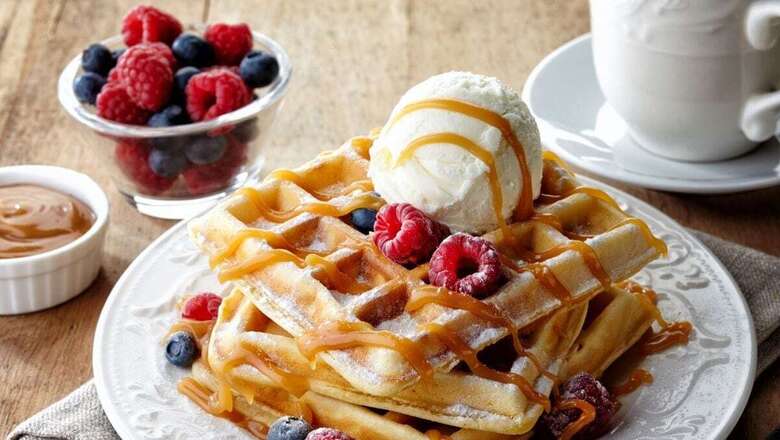
views
When I try and think back to the days, over 45 years ago, when I lived with my grand-father and grand-mother, I cannot help think about the amount of food she cooked because we always had a rather bad-tempered cook. She never really cooked our daily meals, or ventured anywhere near his kitchen during lunch times. But my grandmother was always cooking something special either for breakfast, tea-time or dinner.
Saturday breakfasts were always elaborate. She would defrost all the sausages, ham and bacon. She would then either fry up eggs sunny-side-up, in pure butter or make soft, creamy scrambled eggs with a long slit green chilli hidden inside the golden creaminess. Then she would sear the slices of bread in the same pan till the bread turned golden and slightly crispy on the outside. Who would have even dreamt that eating so much bread, fried in butter, would be the cause of my overabundant disposition. Happiness was dipping the fried bread into the yolk and wolfing it down with rashers of crisp streaky bacon, or apportioning scoops of lush scrambled egg onto buttered toast, sprinkled with black pepper and losing count of how many slices I had eaten. Even her omlettes were fluffy because she would separate the white and the yolk, beat the white stiff like for a meringue and then fold in the yellow, the onions, cheese and whatever else very gently, and poured it onto a hot pan. Then quickly cover the pan so that the omlette would rise and became even more airier.
But the glorious days were those days she would make waffles. We children would sit around the large 10-seater dining table and watch her make the batter, flavour it with vanilla. She would then bring out her really heavy waffle iron. Those were the days when it was quite difficult to buy a waffle iron in India. My grandfather had seen it on one of his trips abroad and had brought home the design and had a foundry. It wasn’t an electric waffle iron, it was stove-top version. You poured the batter into these heavy hinged plates or moulds, which had gridded indentations to shape the waffle. My grandmother’s waffle iron made lovely heart-shaped waffles. As they came out six at a time, piping hot, the whole room smelling of vanilla, she’d have soft butter and a jar of honey, ready to serve them out to us. That taste is still in my heart and mind today. The only other waffles that came even close were the ones they served at The Willingdon Club. We were children, and not allowed in most parts of the club, so it was either at the swimming pool or at the badminton courts that we could order the waffles. The only difference was that they served the waffles with a jug full of warm melted butter that you could pour into those lovely diamond shaped indents in the golden-brown waffle and then smear it with honey or golden syrup.
Today, there are waffle shops at every corner, even one of the more predominant Gujarati Street food parades in Kandivali have waffles being made on the road, a far cry from the days when waffles were a rather elite offering. Unfortunately for me, waffles nowadays are served with huge helpings of canned cream, fruit, Nutella, chocolate sauce, nuts, nougat, and what not. And they are called Belgian Waffles.
I had never heard of Belgian Waffles, just the usual waffles. I also had no idea that they were so famous. I first ate one in New York for dessert. Waffles for dessert? Big fat waffles topped with the most fattening things, very different from the ones I grew up eating. Well, the obvious difference between a Belgian waffle and regular waffle is in the waffle maker itself. The waffle makers, you make Belgian waffles in are larger and have larger squares. So, they make deeper indents in your waffle to hold all the stuff you pour on top of them. Although the waffle is known as a traditional street food in Belgium, waffles in some form or the other have been around for a long time. Food experts believe a kind of waffles were first made in ancient Greece. Flat cakes baked between metal plates fixed to long wooden handles placed on heated stones and then flipped so that both sides received equal heat. Sounds like a waffle to me.
While I still pine for my grand-mother’s waffles, and The Willingdon Club now has a thicker waffle maker. I quite like what’s happened with waffles around the world. There is a vast variety of waffles to be had. Starting with the Belgian Waffle or what could also be called the Brussels Waffle. Big rectangular or squared waffles, crispy on the outside and fluffy on the inside, with large deep pockets for the chocolate sauce, fruits, whipped cream, or even ice cream. Then there is the Liege Waffle. Sweeter, heavier though little smaller than Belgian waffle and with a caramelized sugar coating on the outside. Ever heard of Stroopwafels? Even I hadn’t heard of them. They are thin, round flat waffles made from sweet baked dough held together by a voluptuous gooey filling of molasses, brown sugar, and cinnamon. Then there are the Toaster waffles. They were my go-to waffles when I first moved into my own flat. They were quite difficult to find because there was only one Parsi lady in South Mumbai who made them and sold them frozen in sealed bags in select cold storages. But they were wonderful, you could pop them, into a toaster and they’d pop out crisp and golden on the outside and soft on the inside.
The Americans who love anything with a carb overload, also make savoury waffles. These savoury American Waffles are a bit thinner than the full-bodied Belgian ones, and are not always served with sweet toppings like chocolate sauce, butter, fruits, or maple syrup. Instead, they are often served with chicken, fish, or other savory dishes.
Even Asia and the far east do their own kind of waffles. Vietnamese style Pandan Waffles (Banh Kep La Dua) are bright green, a bit chewy, fluffy as well as crispy, and are common street food. You find them being cooked everywhere in waffle irons over hot coals. These waffles are made with coconut milk and are flavoured with pandan extract, basically, bursting with coconut and pandan flavours.
And finally, the Chinese Egg waffle often called Bubble waffle because they look like big bubbles or eggs and are hollow. Locally called “gai daan jai” they are in-between a cookie and sponge cake, just in the form of balls. Traditionally, they come in flavours such as chocolate, green-tea, ginger, but are nowadays available in many others like green tea, chocolate, cheese or purple sweet potato.
There are, of course, several more waffle varieties because in food, you can always go as far as your imagination does. And with waffles, trust me, people have a very vivid imagination.
Kunal Vijayakar is a food writer based in Mumbai. He tweets @kunalvijayakar and can be followed on Instagram @kunalvijayakar. His YouTube channel is called Khaane Mein Kya Hai. The views expressed in this article are those of the author and do not represent the stand of this publication.

















Comments
0 comment